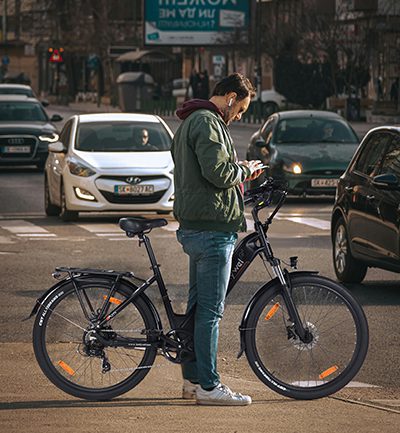E-bikes, or electric bikes, are revolutionizing the way people commute, exercise, and explore the world around them. Whether you’re looking to reduce your carbon footprint, enjoy a quicker commute, or simply have more fun on your rides, an e-bike might be the perfect solution. But with so many options on the market, how do you know which one is right for you? In this guide, we’ll break down everything you need to know before buying an e-bike.
What Is an E-bike?
An e-bike is essentially a traditional bicycle that has been equipped with an electric motor and battery to assist with pedaling. The motor provides additional power, making it easier to ride over long distances, up steep hills, or against strong winds. There are different types of e-bikes, from those with minimal electric assistance to fully electric models where the motor does most of the work.
Types of E-bikes
- Pedal-Assist (Pedelec)
This is the most common type of e-bike. With pedal assist, the motor only activates when you pedal. The harder you pedal, the more assistance the motor provides, but you still have to do the legwork. Pedelecs are ideal for those who want help but still enjoy the physical exercise of cycling. - Throttle-Controlled E-bikes
These bikes let you control the motor with a throttle, similar to a scooter or motorcycle. You don’t need to pedal at all if you don’t want to! These are great for people who need a little extra push or prefer a more leisurely ride without much physical effort. - S-Class or Speed Pedelecs
These e-bikes are designed for higher speeds, typically up to 28 mph (45 km/h). They’re often used by commuters who want to cover longer distances more quickly. However, depending on where you live, these may require a license or special regulations.
Key Features to Consider
When selecting an e-bike, it’s important to keep in mind several key features to ensure you’re getting the best value for your needs.
- Fuerza de motor
The motor is the heart of any e-bike. It typically ranges from 250W to 750W for most standard models. More powerful motors will give you better performance on steep hills or rough terrain. If you’re just using your bike for commuting on flat roads, a 250W motor will likely suffice. - Battery Life & Range
Battery life is one of the most important considerations. The average range of an e-bike is between 20-60 miles on a full charge, depending on factors such as terrain, rider weight, and assist mode. If you’re planning longer rides, consider a battery with a higher capacity or a spare battery for extended range. - Frame & Build
The frame design will affect how comfortable your ride is, as well as how easy it is to handle. E-bikes are available in various frame styles, including mountain bike frames, road bike frames, and cruiser bike frames. Think about the type of terrain you’ll be riding on and how much comfort you need. - Frenos
Since e-bikes can go faster than regular bikes, having reliable brakes is critical for safety. Disc brakes (either mechanical or hydraulic) are common on e-bikes, as they provide more stopping power, especially on wet or uneven surfaces. - Peso
E-bikes can be heavier than traditional bikes due to the motor and battery. If you plan on lifting your bike often (e.g., carrying it upstairs), consider a lightweight frame made from materials like aluminum or carbon fiber. Keep in mind that the added weight can affect the bike’s overall feel and maneuverability.
What Are the Benefits of E-bikes?
- Faster Commute
E-bikes allow you to reach your destination faster by providing power assistance, especially useful when dealing with hills, traffic, or wind. You may even find that you can replace your car or public transport trips with an e-bike for a quicker, more cost-effective option. - Environmentally Friendly
By replacing car trips with e-bike rides, you’re helping to reduce your carbon footprint and contributing to cleaner air. Plus, e-bikes are generally much more energy-efficient than cars. - Beneficios de la salud
E-bikes still provide a workout, especially when you choose pedal-assist modes. You get the benefits of cycling—improved cardiovascular health, increased muscle strength, and better mental well-being—without the strain of a traditional bike. - Económico
Though the initial price of an e-bike can be higher than a regular bike, the long-term savings can add up. No fuel costs, minimal maintenance, and less reliance on public transport or cars mean you could save money over time.
Things to Keep in Mind
- Costo
E-bikes generally range from $1,000 to $5,000, depending on the features and quality of the components. While there are budget-friendly options, high-end models with advanced technology or specialized motors can be significantly more expensive. - Mantenimiento
Although e-bikes require less maintenance than cars, they do need some attention, especially about the battery, motor, and brakes. Be sure to have your e-bike serviced regularly to keep it in top condition. - Legal Considerations
Different countries and states have different laws governing the use of e-bikes. Be sure to check local regulations regarding motor power limits, speed limits, helmet requirements, and where e-bikes are allowed. - Storage and Charging
Since the battery must be charged regularly, you’ll need to make sure you have a safe place to store your e-bike and an accessible outlet for charging. Some bikes allow you to remove the battery for easier charging.
Conclusión
E-bikes offer an exciting and sustainable way to travel. Whether you’re looking for a fun recreational ride or an eco-friendly commuting option, there’s an e-bike out there to suit your needs. By considering the motor power, battery life, and other key features, you can find the right model to make your riding experience enjoyable and efficient. Happy cycling!


